Six new species of the genus Dicranosepsis Duda (Diptera, Sepsidae) from Vietnam, with a revised key to the species
Abstract
The flies of the genus Dicranosepsis from Vietnam were investigated and classified taxonomically. Six new species (D. longa sp. nov., D. kurahashii sp. nov., D. monoseta sp. nov., D. sinuosa sp. nov., D. barbata sp. nov., and D. vietnamensis sp. nov.) are described and illustrated. Dicranosepsis is redefined and a revised key to the species is also provided.
INTRODUCTION
Flies of the genus Dicranosepsis Duda are distributed in the Oriental, Australasian and Afrotropical regions, and they are well-represented in the Orient (Zuska 1977, 1980, 1989; Zuska & Pont 1984). The adults are found on dung, excrement, and manure heaps, and the larvae of some species are known to occur on both cow dung and human excrement (Meier 1996). The oriental species have been studied by Duda (1926), Steyskal (1966), Munari (1982), Iwasa (1984, 1989), Iwasa and Tewari (1990), and Iwasa and Jayasekera (1994). Ozerov (1996) reviewed 21 Dicranosepsis species from around the world and provided a key to the species, and, thereafter, Iwasa (1999) and Ozerov (2003) added four species each, resulting in a total of 29 species at the present time. However, taxonomic knowledge of Dicranosepsis species from South-East Asia is still insufficient. In Vietnam, only seven species in this genus have hitherto been recorded (Ozerov 2005).
Recently, we had the chance to investigate Dicranosepsis species in the course of our survey of dipterous flies in Vietnam. As a result of this investigation, six species new to science were found. Furthermore, in Iwasa (1999) and the present study species were found that have the following new characteristics: katepisternum anteriorly shining (anterodorsal pruinose margin absent), fore coxae sinuate, and genal lower part with wavy hairs instead of genal setae. Therefore, the genus Dicranosepsis must be redefined.
In the present paper, we describe these new species and redefine Dicranosepsis, and provide a revised key to males of Dicranosepsis species based on the key of Ozerov (1996). Females were not treated in this key because of the difficulty in distinguishing the species.
MATERIALS AND METHODS
The surveyed areas are mountainous zones of Lao Cai and Lai Chau Provinces, Vietnam, which are located in the north-west of Vietnam. The areas are between approximately 800 m and 2000 m a.s.l., and they comprise valleys, riversides and hilly open land on which cattle graze. The vegetation in the study areas was mainly secondary forest and shrubby zones.
Most specimens were taken by sweepnet in October of 1995 and 1999. All specimens obtained were pinned and observed under a stereomicroscope. The male genitalia were observed after maceration in 10% KOH. The total number of specimens examined was 112 (six holotypes and 106 paratypes).
The holotypes and some of the paratypes will be preserved at Obihiro University of Agriculture and Veterinary Medicine (OU), Obihiro, Hokkaido. The remaining paratypes will be kept at the Institute of Ecology and Biological Resources (IEBR), Hanoi, Vietnam.
The terminology follows that used by McAlpine (1981). Abbreviations used in the descriptions are as follows. Head: oc, ocellar setae; or, upper fronto-orbital setae; pvt, postvertical setae; vte, outer vertical setae; vti, inner vertical setae. Thorax: dc, dorsocentral setae; m, mesopleural setae; npl, notopleural setae; sa, supra-alar setae; pa, postalar setae; pprn, postpronotal setae; sc, scutellar setae. Wings: bm, basal medial cell.
Genus Dicranosepsis Duda
Dicranosepsis Duda (1926a): 43 [as a subgenus of Sepsis]. Type species: Sepsis bicolor Wiedemann, 1830, by original designation.
Head usually with a pair of genal setae in genal lower margins, but rarely covered with long wavy hairs; 1 oc, 1 vti, 1 vte, 1 pvt; or absent; katepisternum anteroventrally shining, but rarely anteriorly shining (pruinose stripe along dorsal margin absent); mediotergite shining under scutellum; anepimeron completely pruinose, anteriorly shining or with centrally shining spot; 1 pprn, 2 npl, 2 dc, 1 sa, 1 pa, 1 m, 1 sc; coxae usually straight, but rarely sinuate; fore trochanters sometimes extended ventrally or elongated; mid-tibia sometimes with blackish tubercle accompanied by developed preapical setae at the distal end; tarsomeres of forelegs usually cylindrical, but rarely flattened; wings mostly without or rarely with black spot at near apex: fourth sternite oval or rounded triangular-shaped and sparsely covered with several setae, not characterized like Themira; surstyli fused to epandrium, symmetrical, and bifurcated apically.
TAXONOMY
Dicranosepsis longa Iwasa sp. nov. (Figs 1–4)
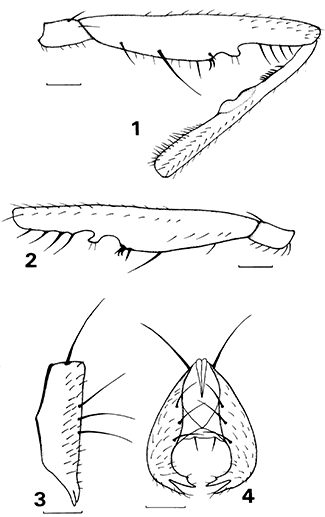
Dicranosepsis longa Iwasa sp. nov. 1 Male left fore femur, tibia and trochanter, anterior view (holotype); 2 Male left fore femur and trochanter, posterior view (holotype); 3 Male epandrium, left lateral view (paratype); 4 Male epandrium, posterior view. Scale lines: 0.1 mm.
Male. Head: frons black and shiny; almost all face dark brown to black; facial orbit dark brown; gena and occiput black and thinly pruinose; antennal segments entirely black, pubescent; arista black and bare; vibrissal angle with 3 moderately developed setae; genal margin with at least 10 peristomal setae in a row and a strong seta at genal angle; 1 oc, 1 vti, 1 vte, 1 pvt; or absent.
Thorax: wholly black; mesonotum, scutellum, and postpronotal lobe thinly pruinose: proepisternum thinly pruinose; anepisternum glossy; katepisternum anteroventrally shining and posterodorsally pruinose; anepimeron anteriorly shining and posteriorly pruinose; meron thinly pruinose; katatergite and metanotum thinly pruinose, central part of metanotum shining; 1 pprn, 2 npl, 2 dc, 1 sa, 1 pa, 1 m, 1 sc. Wing: hyaline, slightly tinged with brown and without dark spot near apex; veins dark brown; humeral cell and basal part of costal cell light brown; anal vein approximately 7 times as long as the width of bm cell; alula without a distinct posterodistal lobe, with marginal microtrichia; halter yellow, darkened basally. Legs: all coxae and trochanters normal and simple; fore femur (Figs 1,2) yellow, basally with 2 distinct anteroventral setae, 1 of which is very long (approximately 3 times as long as the other), and submedianly with a group of spinules and 1 small tubercle, and 3–4 ventral setae in the distal part; mid-femur dark brown and hind femur yellow, both without any distinct setae or spines; fore tibia with a row of 5–7 ventral short spinules in the basal third and ventrally with setulae in the distal third; middle tibia yellow with an anteroventral seta at the distal third and ventrally covered with distinct setulae in the distal half: hind tibia yellow and anterodorsally with a darkened mark like an osmeterium near the middle; all tarsi yellow, darkened apically; hind first tarsomere with a row of anteroventral setae that are approximately 1.3 times as long as the width of first tarsomere.
Abdomen: black and shiny; tergites sparsely clothed with setulae, without macrochaetae; third sternite longitudinally elongate with 4–5 pairs of setulae; 4th sternite rounded triangular-shaped and sparsely covered with 12–13 setulae; epandrium slender in lateral view, with a pair of strong dorsal setae and 3 pairs of posterior setae (Fig. 3); upper part of surstylus with slight projection (Fig. 4).
Body length: 3.0–3.8 mm (n = 20).
Female. Unknown.
Holotype. ♂, Sapa (1850 m a.s.l.), Lao Cai, Vietnam, 6.x.1999, M. Iwasa (OU).
Paratypes. 10♂, same data as holotype (IEBR); 25♂, same locality as holotype, 4–5.x.1999, M. Iwasa (OU); 9♂, Phang Si Pang (1970 m a.s.l.), Lai Chau Province, 4.x.1995, H. Kurahashi (OU).
Distribution. Vietnam.
Etymology. This species is named for the long anteroventral seta on the male fore femur.
Remarks. This species is easily distinguishable from previously described species of Dicranosepsis in having 1 short and 1 long anteroventral seta at the basal third of the male fore femur. The adults were collected from cow dung.
Dicranosepsis kurahashii Iwasa sp. nov. (Figs 5–8)
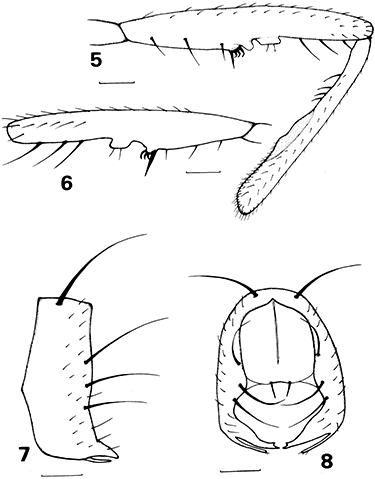
Dicranosepsis kurahashii Iwasa sp. nov. 5 Male left fore femur and tibia, anterior view (holotype); 6 Male left fore femur, posterior view (holotype); 7 Male epandrium, left lateral view (paratype); 8 Male epandrium, posterior view. Scale lines: 0.1 mm.
Male. Head: frons black and shining; face and facial orbit dark brown to black; gena and occiput black and thinly pruinose; antennal segments entirely black, third segment pubescent; arista black and bare; vibrissal angle with 3 moderately developed setae; genal margin with more than 10 peristomal setae in a row and 1 strong seta at genal angle; 1 oc, 1 vti, 1 vte, 1 pvt; or absent.
Thorax: wholly black; mesonotum and scutellum thinly pruinose; postpronotal lobe thinly pruinose in anterior half and posteriorly shining; proepisternum thinly pruinose; anepisternum glossy; katepisternum anteroventrally shining and posterodorsally pruinose; anepimeron anteriorly shining and posteriorly pruinose; meron thinly pruinose; katatergite and metanotum subshining, central part of metanotum glossy; 1 pprn, 2 npl, 2 dc, 1 sa, 1 pa, 1 m, 1 sc. Wings: hyaline, slightly tinged with brown, without dark spot near apex; veins dark brown; humeral cell and basal part of costal cell light brown; anal vein approximately 7 times as long as the width of bm cell; alula without a distinct posterodistal lobe, bearing microtrichia marginally; halter yellow, darkened basally. Legs: fore coxae slightly bent innerside; all trochanters normal and simple; fore femur (Figs 5,6) yellow, with 2 anteroventral setae in the basal third, 1 of which is 2 times as long as the other, and with small anteroventral and ventral tubercles preceded by a median group of spinules, and with 3 ventral setae distally; mid- and hind femora yellow and without any distinct setae or spinules; fore tibia (Fig. 5) with 3–4 ventral spinules in the basal third and ventrally covered with setulae in the distal third; middle tibia yellow, with an anteroventral seta at the distal third; hind tibia yellow, anterodorsally with a weak darkened mark like an osmeterium near the middle; all tarsi yellow, darkened apically; hind first tarsomere with a row of anteroventral setae that are approximately 2 times as long as the width of the first tarsomere.
Abdomen: black and shining; tergites sparsely with setulae, without macrochaetae; third sternite longitudinally elongate with 3 pairs of setulae; 4th sternite rounded triangular-shaped and sparsely covered with 9–10 setulae; epandrium comparatively thick in lateral view with a pair of strong dorsal setae and 3 pairs of posterior setae, and anteroventral part perpendicular (Fig. 7); upper part of surstylus with slight projection (Fig. 8).
Body length: 3.5–3.8 mm (n = 13).
Female. Unknown.
Holotype. ♂, Sapa (1850 m a.s.l.), Lao Cai, Vietnam, 6.x.1999, M. Iwasa (OU).
Paratypes. 6♂, same data as holotype (IEBR); 4♂, same locality as holotype, 4.x.1999, M. Iwasa (OU); 2♂, Mount Phang Si Pang (1970 m a.s.l.), Lai Chau, Vietnam, 4.x.1995, H. Kurahashi (OU).
Distribution. Vietnam.
Etymology. This species is named after Dr H. Kurahashi, who collected some of the type specimens.
Remarks. This species resembles D. longa sp. nov. in the structure of the male foreleg, but is distinguishable from it by having 3 anteroventral setae equidistant to each other in the basal half of the fore femur and by the shape of the epandrium in males (the ventral part of the epandrium is perpendicular to the anterior margin of the epandrium in lateral view). The adults were collected from cow dung.
Dicranosepsis monoseta Iwasa sp. nov. (Figs 9–12)
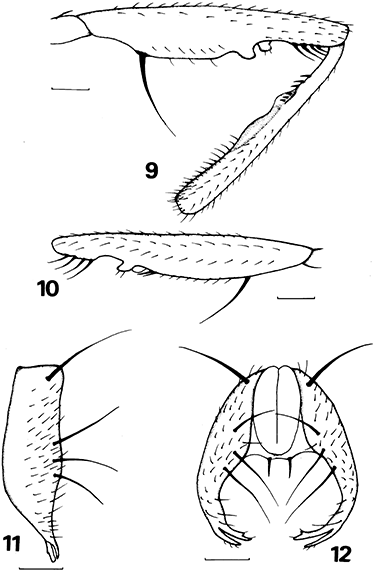
Dicranosepsis monoseta Iwasa sp. nov. 9 Male left fore femur and tibia, anterior view (holotype); 10 Male left fore femur, posterior view (holotype); 11 Male epandrium, left lateral view (paratype); 12 Male epandrium, posterior view. Scale lines: 0.1 mm.
Male. Head: frons black and shining; face and facial orbit dark brown to black; gena and occiput black and thinly pruinose; antennal segments entirely black, third segment pubescent; arista black and bare; vibrissal angle with 2–3 moderately developed setae; genal margin with a row of peristomal setae and 1 strong seta at genal angle; 1 oc, 1 vti, 1 vte, 1 pvt; or absent.
Thorax: wholly black; mesonotum and scutellum thinly pruinose; postpronotal lobe thinly pruinose, shining only around pprn seta: proepisternum thinly pruinose; anepisternum glossy; katepisternum anteroventrally shining and posterodorsally pruinose; anepimeron anteriorly shining or subshining and posteriorly pruinose; meron thinly pruinose; katatergite and metanotum subshining, central part of metanotum glossy; 1 pprn, 2 npl, 2 dc, 1 sa, 1 pa, 1 m, 1 sc. Wings: hyaline, slightly tinged with brown without dark spot near apex; veins dark brown; humeral cell and basal part of costal cell light brown; anal vein approximately 8 times as long as the width of bm cell; alula without a distinct posterodistal lobe, with microtrichia marginally; halter yellow, darkened basally. Legs: all coxae and trochanters normal and simple; fore femur (Figs 9,10) yellow, with a prominently strong ventral seta at the basal 4th and an anteroventral and a posteroventral tubercle followed by 1–2 short posteroventral setae at the near distal third, and with 3–4 setae distally; middle and hind femora yellow and without any distinct setae or spines; fore tibia (Fig. 9) with a row of ventral spinules in the basal third and ventrally clothed with setulae in the distal third; middle tibia yellow, with an anteroventral seta at the distal third and ventrally covered with distinct setulae in the distal half; hind tibia yellow, anterodorsally with a darkened mark like an osmeterium near the middle; all tarsi yellow, darkened apically; first hind tarsomere with a row of anteroventral setae as long as the width of first tarsomere.
Abdomen: black and shining; tergites sparsely clothed with setulae, without macrochaetae; third sternite longitudinally elongate with 5 pairs of setulae; 4th sternite rounded triangular-shaped and sparsely covered with 12–13 setulae; epandrium slender in lateral view with a pair of strong dorsal setae and 3 pairs of posterior setae (Fig. 11); upper part of surstylus with slight projection (Fig. 12).
Body length: 3.0–3.8 mm (n = 7).
Female. Unknown.
Holotype. ♂, Sapa (1850 m a.s.l.), Lao Cai, Vietnam, 6.x.1999, M. Iwasa (OU).
Paratypes. 5♂, same data as holotype (IEBR); 1♂, same locality as holotype, 4.x.1999, M. Iwasa (OU).
Distribution. Vietnam.
Etymology. This species is named for the strong ventral seta at the basal part of the male fore femur.
Remarks. This species is easily distinguishable from other species of Dicranosepsis by having a prominently strong ventral seta at the basal 4th of the male fore femur. The adults were collected from cow dung.
Dicranosepsis sinuosa Iwasa sp. nov. (Figs 13–17)
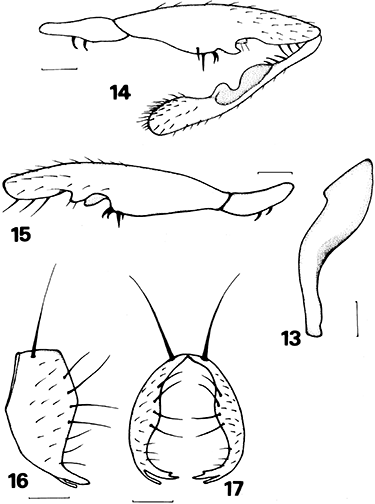
Dicranosepsis sinuosa Iwasa sp. nov. 13 Male left fore coxa, anterior view (holotype); 14 Male left fore trochanter, femur and tibia, anterior view (holotype); 15 Male left fore trochanter and femur, posterior view (holotype); 16 Male epandrium, left lateral view (paratype); 17 Male epandrium, posterior view. Scale lines: 0.1 mm.
Male. Head: frons black and shining; face and facial orbit dark brown, facial carina brown; gena and occiput black and thinly pruinose; antennal segments entirely black, third segment pubescent; arista black and bare; vibrissal angle with 3 moderately developed setae; genal margin with a row of peristomal setae and 1 strong seta at genal angle; 1 oc, 1 vti, 1 vte, 1 pvt; or absent.
Thorax: wholly black; mesonotum and scutellum thinly pruinose; postpronotal lobe thinly pruinose, and shining only around pprn seta; proepisternum thinly pruinose; anepisternum glossy; katepisternum anteroventrally shining and posterodorsally pruinose; anepimeron anteriorly shining and posteriorly pruinose; meron thinly pruinose; katatergite and metanotum subshining, central part of metanotum glossy; 1 pprn, 2 npl, 2 dc, 1 sa, 1 pa, 1 m, 1 sc. Wings: hyaline, slightly tinged with brown, without dark spot near apex; veins dark brown; humeral cell and basal part of costal cell light brown; anal vein approximately 6.5 times as long as the width of bm cell; alula without a distinct posterodistal lobe, bearing microtrichia marginally; halter yellow, darkened basally. Legs: fore coxae (Fig. 13) yellow, sinuate and thick in basal half; fore trochanters (Fig. 14) elongate, with 2 distinct ventral spinules curled apically; fore femur (Figs 14,15) yellow, with an anteroventral and a posteroventral tubercle preceded by a median group of spinules and distally with 3 ventral setae; middle and hind femora yellow and without any distinct setae or spinules; fore tibia (Fig. 14) with 3–4 ventral spinules in the basal third and excavated at the middle; middle tibia yellow, with an anteroventral seta at the distal third; hind tibia yellow, anterodorsally with a darkened mark like an osmeterium; fore and middle first tarsomeres yellow, darkened apically; hind first tarsomere with a row of anteroventral setulae that are approximately 2 times as long as the width of first tarsomere; second to fifth tarsomeres entirely black.
Abdomen: black and shining; tergites sparsely with setulae, without macrochaetae; third sternite longitudinally elongate with 3–4 pairs of setulae; 4th sternite oval and sparsely covered with 9–10 setulae; epandrium comparatively thick in lateral view with a pair of strong dorsal setae and 4 pairs of posterior setae, and anteroventral part of epandrium gently curved (Fig. 16); upper part of surstylus with slight projection (Fig. 17).
Body length: 3.3–3.5 mm (n = 20).
Female. Unknown.
Holotype. ♂, Sapa (1850 m a.s.l.), Lao Cai, Vietnam, 5.x.1999, M. Iwasa (OU).
Paratypes. 15♂, same data as holotype (IEBR); 11♂, same locality as holotype, 4.x.1999, M. Iwasa (OU); 6♂, Mount Phang Si Pang (1970 m a.s.l.), Lai Chau, Vietnam, 4.x.1995, H. Kurahashi (OU); 2♂, Sapa (1500 m a.s.l.), Vietnam, 2.x.1995, H. Kurahashi (OU).
Distribution. Vietnam.
Etymology. This species is named for the sinuate fore coxae in males.
Remarks. This species is remarkable in Dicranosepsis for having sinuate coxae and elongate trochanters in the male forelegs. The adults were collected from cow dung.
Dicranosepsis barbata Iwasa sp. nov. (Figs 18–22)
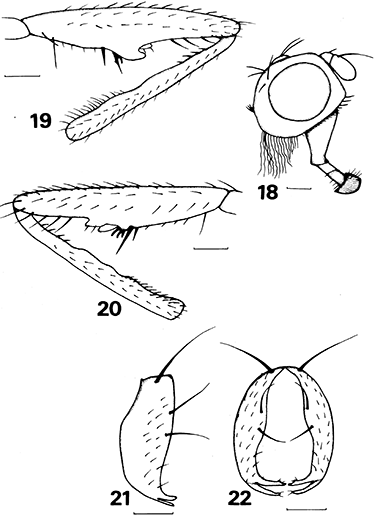
Dicranosepsis barbata Iwasa sp. nov. 18 Head, right lateral view (holotype); 19 Male left fore femur and tibia, anterior view (holotype); 20 Male left fore femur and tibia, left posterior view; 21 Male epandrium, left lateral view (paratype); 22 Male epandrium, posterior view. Scale lines: 0.1 mm.
Male. Head: frons black and shining; face black, facial carina brown; gena and occiput black and thinly pruinose; antennal segments entirely black, third segment pubescent; arista black and bare; vibrissal angle with 3 moderately developed setae; genal margin with a row of peristomal setae, and genal lower part with long and wavy hairs instead of a genal seta (Fig. 18), 1 oc, 1 vti, 1 vte, 1 pvt; or absent.
Thorax: wholly black; mesonotum and scutellum thinly pruinose; postpronotal lobe thinly pruinose, with posterior shining spot around pprn seta; proepisternum thinly pruinose; anepisternum glossy; katepisternum anteroventrally shining and posterodorsally pruinose; anepimeron anteriorly shining and posteriorly pruinose; meron thinly pruinose; katatergite and metanotum subshining, central part of metanotum widely glossy; 1 pprn, 2 npl, 2 dc, 1 sa, 1 pa, 1 m, 1 sc. Wings: hyaline, slightly tinged with brown; veins dark brown; humeral cell and basal part of costal cell light brown; anal vein approximately 5.5 times as long as the width of bm cell; alula without a distinct posterodistal lobe, bearing microtrichia marginally; halter yellow, darkened basally. Legs: all coxae and trochanters normal and simple; fore femur (Figs 19,20) yellow, with 2 anterobasal setae, and antero- and posteroventral tubercles preceded by a median group of spinules, and distally with 3–4 ventral setae; middle and hind femora yellow and without any distinct setae or spinules; fore tibia (Figs 19,20) with 3–4 ventral spinules in the basal third and ventrally covered with setulae in the distal third; middle tibia yellow, with an anteroventral seta at the distal third; hind tibia yellow, anterodorsally with a darkened mark like an osmeterium near the middle; all tarsi yellow, darkened apically; hind first tarsomere with a row of anteroventral setae that are as long as the width of first tarsomere.
Abdomen: black and shining; tergites sparsely with setulae, without macrochaetae; third sternite longitudinally elongate with 4–5 pairs of setulae; 4th sternite oval and sparsely covered with 9–10 setulae; epandrium comparatively thin in lateral view with a pair of strong dorsal setae and 2 pairs of posterior setae, and anteroventral part of epandrium gently curved (Fig. 21); upper part of surstylus with slight projection (Fig. 22).
Body length: 2.9–3.0 mm (n = 4).
Female. Unknown.
Holotype. ♂, Mount Phang Si Pang (1970 m a.s.l.), Lai Chau, Vietnam, 4.x.1995, H. Kurahashi (OU).
Paratypes. 2♂, same data as holotype (IEBR); 1♂, Sapa (1500 m a.s.l.), Vietnam, 2.x.1995, H. Kurahashi (OU).
Distribution. Vietnam.
Etymology. This species is named for the characteristic wavy hairs on the lower genal part of the head in males.
Remarks. This species resembles D. revocans (Walker, 1860) in the structure of the male forelegs, but is easily distinguishable by males having long and characteristic wavy hairs on the lower genal part of the head.
Dicranosepsis vietnamensis Iwasa sp. nov. (Figs 23–28)
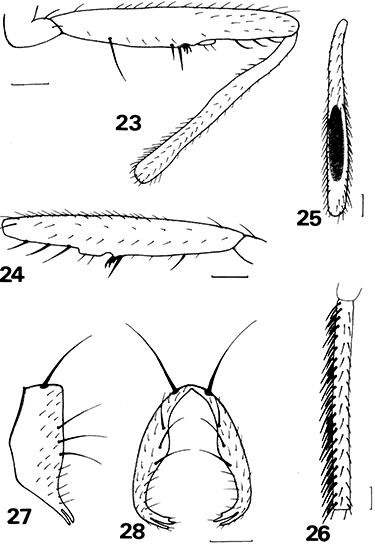
Dicranosepsis vietnamensis Iwasa sp. nov. 23 Male left fore femur and tibia, anterior view (holotype); 24 Male left fore femur, posterior view (holotype); 25 Male first tarsomere of midleg, left anterior view (holotype); 26 Male hind tibia, right posterior view (holotype); 27 Male epandrium, left lateral view (paratype); 28 Male epandrium, posterior view. Scale lines: 0.1 mm.
Male. Head: frons black and shining; face black, facial carina and facial orbit brown; gena and occiput black and thinly pruinose; antennal segments entirely black, third segment pubescent; arista black and bare; vibrissal angle with 3 moderately developed setae; genal margin with more than 10 peristomal setae and with a distinct seta at genal angle; 1 oc, 1 vti, 1 vte, 1 pvt; or absent.
Thorax: wholly black; mesonotum and scutellum thinly pruinose; postpronotal lobe thinly pruinose, with posterior shining spot around pprn seta; proepisternum thinly pruinose; anepisternum glossy; katepisternum anteroventrally shining and posterodorsally pruinose; anepimeron thinly pruinose, only central part shining; meron thinly pruinose; katatergite and metanotum subshining, central part of metanotum glossy; 1 pprn, 2 npl, 2 dc, 1 sa, 1 pa, 1 m, 1 sc. Wings: hyaline, slightly tinged with brown; veins dark brown; humeral cell and basal part of costal cell light brown; anal vein approximately 6.8 times as long as the width of bm cell; alula without a distinct posterodistal lobe, with microtrichia marginally; halter yellow, darkened basally. Legs: all coxae and trochanters normal and simple; fore femur (Figs 23,24) yellow, with a long anteroventral seta at the basal 4th, and with a group of median spinules accompanied by a small posteroventral tubercle next, and distally with 3 ventral setae; middle and hind femora yellow and without any distinct setae or spinules; fore tibia (Fig. 23) with 4–5 ventral spinules in the basal third and ventrally covered with setulae in the distal part; middle tibia yellow, with an anteroventral seta at the distal third and strong apical anteroventral and posteroventral spurs; hind tibia (Fig. 25) yellow, anterodorsally with distinct osmeterium accompanied by comparatively long dorsal setulae; all tarsi yellow, darkened apically; rows of anteroventral and posteroventral setae on mid-first tarsomere somewhat long and stout (Fig. 26); hind first tarsomere with a row of anteroventral setulae that are as long as the width of first tarsomere.
Abdomen: black and shining; tergites sparsely with setulae, without macrochaetae; third sternite longitudinally elongate with 4 pairs of short setulae; 4th sternite rounded triangular-shaped and sparsely covered with 13–14 short setulae; anteroventral part of epandrium angularly curved with a pair of strong dorsal setae and 3 pairs of posterior setae (Fig. 27); upper part of surstylus with slight projection (Fig. 28).
Body length: 3.0–3.3 mm (n = 8).
Female. Unknown.
Holotype. ♂, Sapa (1600 m a.s.l.), Lao Cai, Vietnam, 5.x.1999, M. Iwasa (OU).
Paratypes. 2♂, same data as holotype (IEBR); 1♂, same locality as holotype, 6.x.1999, M. Iwasa (IEBR); 1♂, same locality as holotype, 4.x.1999, M. Iwasa (OU); 3♂, Sapa (800–1200 m a.s.l.), Lao Cai, Vietnam, 6–7.x.1995, Kurahashi (OU).
Distribution. Vietnam.
Etymology. This species is named after the country in which the type specimens were collected.
Remarks. This species is very similar to D. unipilosaDuda, 1926 in the features of the male forelegs, but differs from it in having a long anteroventral seta at the basal third of the fore femur and rows of stout anteroventral and posteroventral setae on the first tarsomere of the midlegs, and a distinct osmeterium on the hind tibia in males.
Key to species of the genus Dicranosepsis Duda (males)
- 1
Wings with dark spot near apex 2
- –
Wings clear, without dark spot near apex 4
- 2
Anepimeron completely pruinose; fore femur without av setae in the basal third 3
- –
Anepimeron shining in anterior half; fore femur with 6 av setae in the basal third D. maculosa Iwasa
- 3
Mid-tibia with a row of long av setae in entire length, without black ring at the distal end D. distincta Iwasa
- –
Mid-tibia with 1–2 av setae in the apical third, with black ring at the distal end D. emiliae Ozerov
- 4
Mid-tibia with black tubercle at the distal end 5
- –
Mid-tibia without black tubercle at the distal end 7
- 5
Black tubercle at the distal end of mid-tibia with 3 curved, preapically compressed and broadened setae D. coryphea Steyskal
- –
Black tubercle at the distal end of mid-tibia without compressed and broadened setae 6
- 6
Katepisternum anteriorly shining (anterodorsal pruinose margin absent); black tubercle at the distal end of mid-tibia with 3 long hair-like preapical setae D. mirabilis Iwasa
- –
Katepisternum anteroventrally shining (anterodorsal pruinose margin present); black tubercle of at the distal end of mid-tibia with 3–4 distinct preapical setae D. nigrinodosa Iwasa
- 7
Genal lower part with long wavy hairs D. barbata Iwasa sp. nov
- –
Genal lower part without long wavy hairs 8
- 8
Anepimeron completely pruinose 9
- –
Anepimeron shining in anterior half or with shining spot anteriorly 19
- 9
Mid-tibia with 3–13 long av setae in apical half 10
- –
Mid-tibia with 1 av seta at the distal third 11
- 10
av setae on first tarsomere of hindleg curved apically D. parva Iwasa
- –
av setae on first tarsomere of hindleg straight D. bicolor (Weidemann)
- 11
Surstylus with distinct dorsal triangular projection D. crinita (Duda)
- –
Surstylus without distinct dorsal projection 12
- 12
Pair of epandrial dorsal setae longer than the length of the epandrium D. tibialis Iwasa et Tewari
- –
Pair of epandrial dorsal setae shorter than the length of the epandrium 13
- 13
Fore tibia with deep incision in the middle D. hamata (de Meijere)
- –
Fore tibia without deep incision in the middle 14
- 14
Upper calypter blackish D. papuana Ozerov
- –
Upper calypter whitish yellow 15
- 15
Fore trochanter strongly or somewhat extended ventrally. 17
- –
Fore trochanter not extended ventrally 16
- 16
Hind trochanter posteriorly covered with hair-like setae D. dudai Ozerov
- –
Hind trochanter without hair-like setae D. transita Ozerov
- 17
Ventral process of fore trochanter same length as body of fore trochanter D. sauteri Ozerov
- –
Ventral process of fore trochanter shorter than body of fore trochanter 18
- 18
Fore femur with 1–2 anterobasal setae D. pseudotibialis Ozerov
- –
Fore femur without anterobasal setae D. renschi Ozerov
- 19
Tarsomeres of foreleg flattened D. plantitarsis Ozerov
- –
Tarsomeres of foreleg cylindrical 20
- 20
Fore coxa sinuate D. sinuosa Iwasa sp. nov.
- –
Fore coxa straight 21
- 21
Mid-tibia bent innerside near the middle; hind tibia with a hollowed osmeterium anterodorsally D. olfactoria Iwasa
- –
Mid-tibia straight; hind tibia without a hollowed osmeterium 22
- 22
Pleural wing process shining; mid-tibia with black ring at apex D. takoensis (Vanschuytobroek)
- –
Pleural wing process pruinose; mid-tibia without black ring at apex 23
- 23
Proepisternum shining in upper part D. iwasai Ozerov
- –
Proepisternum completely pruinose 24
- 24
Fore femur with 4 pv setae in the basal third D. stabilis Iwasa
- –
Fore femur without pv setae in the basal third 25
- 25
Anterior part of anepimeron thinly pruinose with a shining spot 26
- –
Anterior third or half of anepimeron completely shining or subshining 28
- 26
Fore femur with 3 long av setae and 1 v seta in the basal third D. quadrigemina Iwasa
- 26
- –
Fore femur with 1–2 av setae in the basal third 27
- 27
Fore femur with 1 long av seta at the basal third; hind tibia with a blackish osmeterium D. vietnamensis Iwasa sp. nov
- 27
- –
Fore femur with 1 short and 1 long av seta in the basal third; hind tibia without a distinct osmeterium D. unipilosa (Duda)
- 28
Fore femur with 3 av setae in the basal half 29
- 28
- –
Fore femur with 0–2 av setae or 1 v seta in the basal half 31
- 29
First to third tarsi of hindleg with a row of long anterior setae that are curled apically D. trichordis Iwasa
- 29
- –
First to third tarsi of hindlegs with a row of anterior setae that are straight 30
- 30
Fore femur with 3 av setae close to each other in the basal fifth of fore femur D. montana Iwasa
- 30
- –
Fore femur with 3 av setae equidistant from each other in the basal half of fore femur D. kurahashii sp. nov. Iwasa
- 31
Fore femur with 1 strong v seta basally D. monoseta sp. nov. Iwasa
- 31
- –
Fore femur without 1 strong v seta basally 32
- 32
Fore femur with 2 av setae in the basal third 33
- 32
- –
Fore femur with 0–2 av setae basally 34
- 33
Distance between av setae in the basal third of fore femur more than length of basal seta and apical end of distal av seta reaches the half-way point of fore femur D. longa sp. nov. Iwasa
- 33
- –
Distance between av setae in the basal fifth of fore femur less than length of basal seta and apical end of distal av seta does not reach the half-way point of fore femur D. revocans (Walker)
- 34
Fore femur with 2 av setae basally and ventrally concave at the distal third D. cavernosa Iwasa
- 34
- –
Fore femur with 0–1 av seta basally and not ventrally concave at the distal third 35
- 35
Fore femur with a short and stout av seta basally; mid-tibia with brown ring at the distal end D. breviappenduculata (de Meijere)
- 35
- –
Fore femur without av seta basally; mid-tibia without brown ring at the distal end D. javanica (de Meijere)
ACKNOWLEDGMENTS
We wish to express our sincere thanks to Drs K. Kurahashi and T. Hayashi of the National Institute of Infectious Diseases, Tokyo, Japan for their kindness in offering the valuable materials. Our thanks are also due to Dr A. L. Ozerov of the Zoological Museum, Moscow Lomonosov State University, Moscow, for his valuable suggestions and to Assistant Professor G. A. Hill of Obihiro University of Agriculture and Veterinary Medicine for checking the English of this manuscript.




